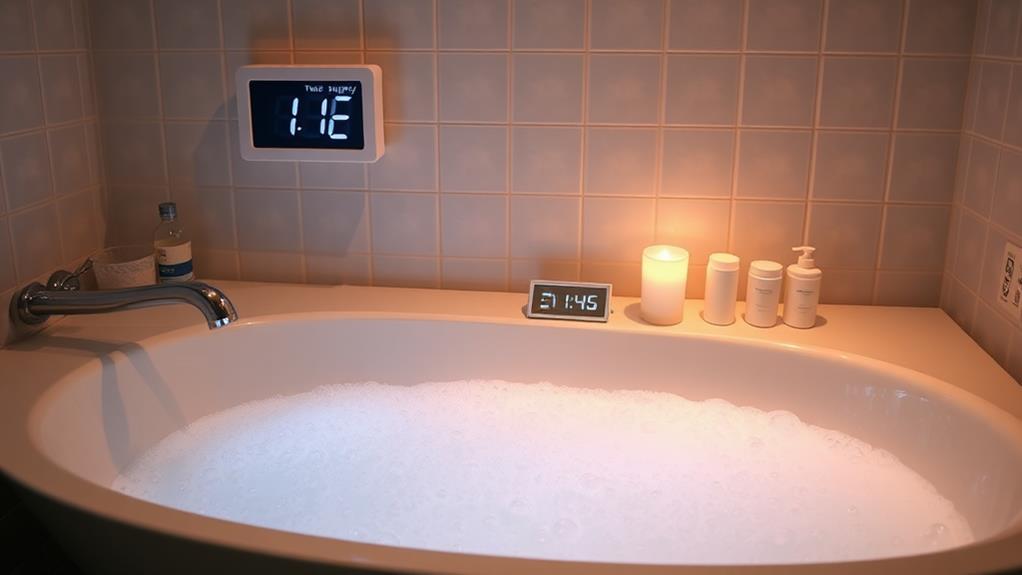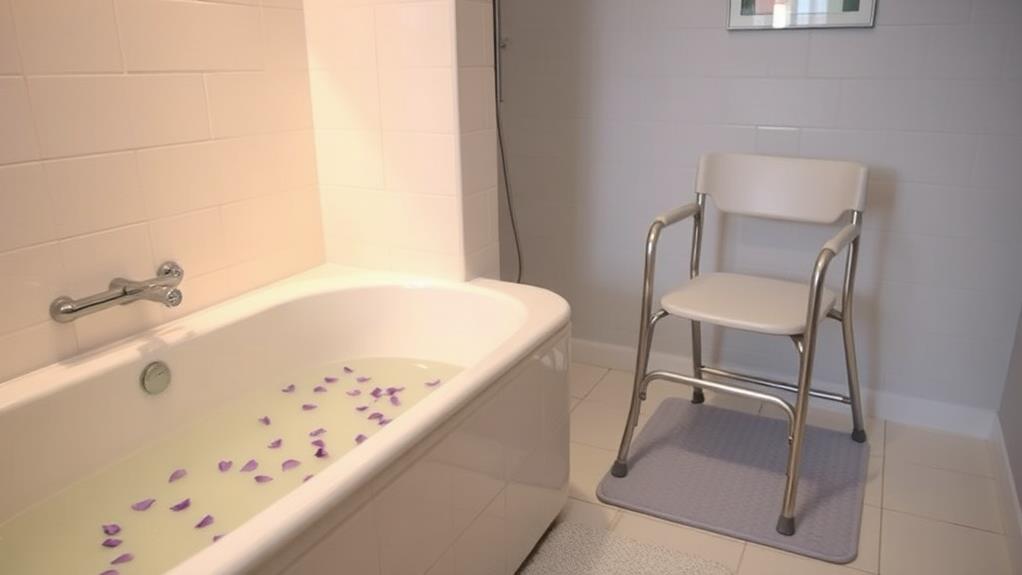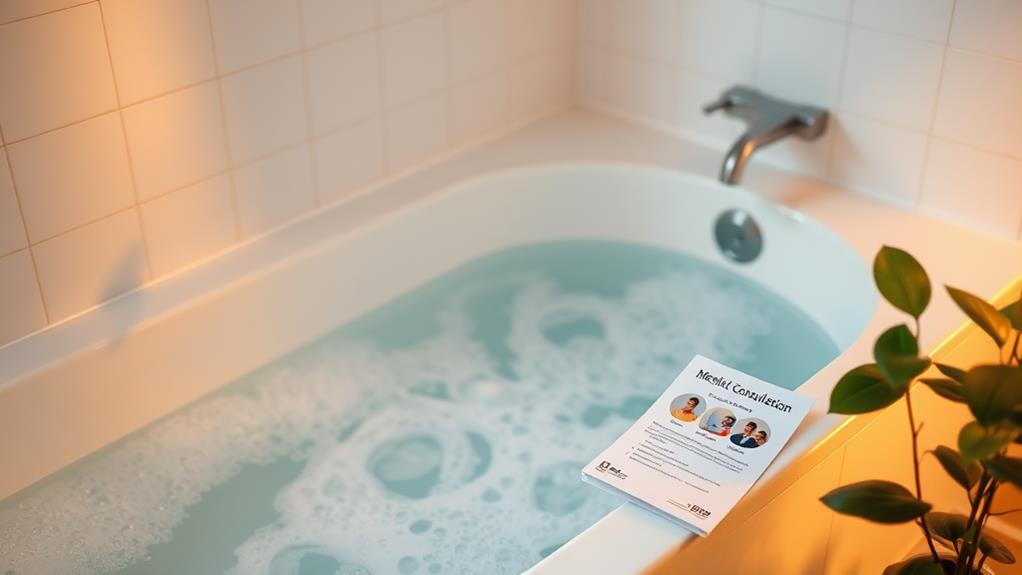Safe Bathing After A C-Section: Benefits & Precautions
After a C-section, you might wonder whether it’s safe to enjoy a bath. It’s understandable, as bathing can provide relaxation and promote healing. However, there are essential guidelines you should follow to guarantee your safety and well-being. Knowing when to take that first bath and how to do it properly can make a significant difference. As you consider your options, there are specific precautions to keep in mind that can help you avoid complications. Curious about what those precautions are and how they can support your recovery?
Importance of Hygiene

After a C-section, maintaining proper hygiene is essential for your recovery. You want to keep that incision clean and dry, so it can heal without any nasty surprises. Washing your hands often is a great start. Trust me, you don’t want to introduce any germs to your healing body! Use soap and warm water, and sing a little song while you scrub—it’s fun and helps you remember to wash long enough.
When it comes to bathing, wait for your doctor’s okay before jumping in the tub. Showers might be your best bet for a while. They’re quick, and you can easily rinse off without worrying about soaking your incision. If you’re feeling adventurous, use a gentle soap. Avoid anything too harsh, as your skin might be sensitive right now.
Also, remember to keep an eye on your incision. If it looks red or puffy, or if you notice any weird smells, don’t hesitate to reach out to your doctor. It’s better to be safe than sorry!
Keeping things clean will help you feel more comfortable and let you focus on what really matters: bonding with your little one!
Benefits of Bathing
Bathing can offer several benefits during your recovery from a C-section. First off, a warm bath can soothe your muscles and help you relax. After major surgery, you might feel tense and achy. Soaking in warm water is like giving yourself a little spa treatment right at home! It can also lift your spirits, helping you feel more like yourself again during a time when everything feels a bit topsy-turvy.
Another perk is improved circulation. The warm water gets your blood flowing, which is great for healing. Plus, it can help reduce swelling around your incision site. A bath can also keep your skin hydrated, especially after all those changes your body has gone through.
Don’t forget about the mental boost! Taking time for yourself, even if it’s just a quick soak, can be a nice break from the chaos of newborn care. It’s your moment to unwind, maybe enjoy some music, or even sneak in a good book.
Just remember, you deserve this time! So, go ahead and enjoy those soothing baths—your body and mind will thank you for it!
Timing for First Bath

Knowing when to take your first bath after a C-section is essential for your recovery. Generally, you should wait about 2 to 4 days after your surgery. This gives your body time to start healing and helps avoid any complications. Remember, your body just went through a major event, and it needs some TLC!
If your healthcare provider gives you the thumbs up, you might feel ready to relax in the tub. Just think about it: a warm bath can feel so soothing after all those hospital beds and bright lights.
However, if you notice any unusual pain, swelling, or signs of infection, it’s best to hold off and check in with your doctor.
Also, keep in mind that while soaking in warm water can be nice, you don’t want to submerge your incision site too soon. You’ll want to keep it clean and dry for ideal healing.
Recommended Bathing Methods
When it comes to bathing after a C-section, there are a few recommended methods to guarantee your comfort and safety.
First, consider sponge baths. They’re a great option in those early days when you’re still healing. Just grab a soft washcloth, some warm water, and your favorite soap. You’ll feel refreshed without soaking your incision.
Once you’re feeling a bit better, you might try a shallow bath. Fill the tub with just a few inches of warm water, and have a seat. This way, you can enjoy the calming effect without putting pressure on your healing belly.
If you’re itching to relax, don’t forget about showering! A gentle shower can be super soothing. Use a handheld showerhead if you have one, so you can direct the water away from your incision.
Remember to keep the water at a comfortable temperature. You want it warm and cozy, but not hot enough to make you sweat.
And hey, don’t forget to keep your bathing area safe and slip-free. Those rubber mats are your best friend! Enjoy your bathing time; you deserve it!
Precautions to Consider

Taking a few simple precautions can make a big difference in your bathing experience after a C-section.
First, always check the water temperature. You don’t want it too hot or too cold; think of it like Goldilocks—just right! A gentle temperature helps your body relax without shocking your healing incision.
Next, consider using a non-slip mat in the tub or shower. Trust me, you don’t want to be doing the splits post-surgery! Your stability is key, so take your time when moving around. If you feel dizzy or weak, it’s totally okay to sit down for a moment.
Also, keep your bathing area tidy. Remove any clutter that could trip you up, and have everything you need within reach. You’ll be in and out of the tub, and you don’t want to be hopping around for shampoo!
Lastly, ask for help if you need it. Whether it’s a friend or family member, having someone nearby can make the experience more enjoyable and safe.
Signs of Infection
After a C-section, it’s crucial to monitor your incision site for any signs of infection. Keeping an eye on your healing process can help you feel more at ease, and it’s super important for your recovery.
Look out for redness, swelling, or warmth around the incision. If you notice any pus or unusual discharge, that’s a red flag!
You should also pay attention to your body temperature. If you find yourself feeling feverish, or if your temperature goes above 100.4 degrees Fahrenheit, it’s worth taking a closer look.
Pain is normal after surgery, but if it suddenly gets worse instead of better, that might be a sign something isn’t right.
Don’t forget about your overall well-being, either. If you’re feeling unusually tired or weak, it’s better to be safe than sorry. Remember, your body just went through a lot!
Staying aware of these signs can help you catch any issues early. So, keep your spirits up, and trust your instincts. If something feels off, it’s always better to check in with a healthcare professional.
You’ve got this!
Seeking Medical Advice

If you notice any signs of infection or have concerns about your recovery, don’t hesitate to seek medical advice. Your well-being is super important, and it’s always better to ask questions than to worry.
If you feel pain that’s worse than what you expected, or if your incision looks red and swollen, give your doctor a call. They’re there to help!
Sometimes, we think we can handle things on our own, but it’s okay to admit you need a little support. After all, you’ve just gone through a big surgery!
If you’re unsure about when it’s safe to take a bath or how to care for your incision, your healthcare provider can guide you.
Also, if you’re feeling down or overwhelmed, don’t keep it to yourself. Talk to your doctor; they can connect you with resources or support groups.




